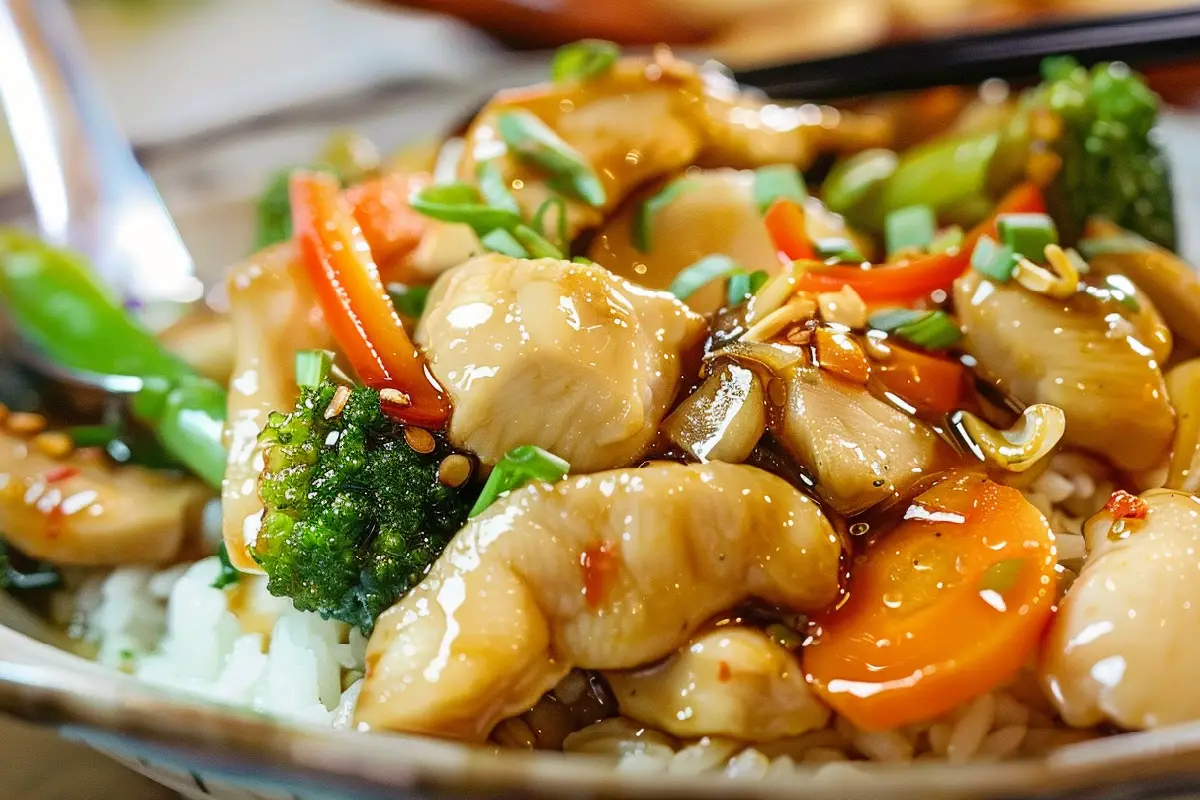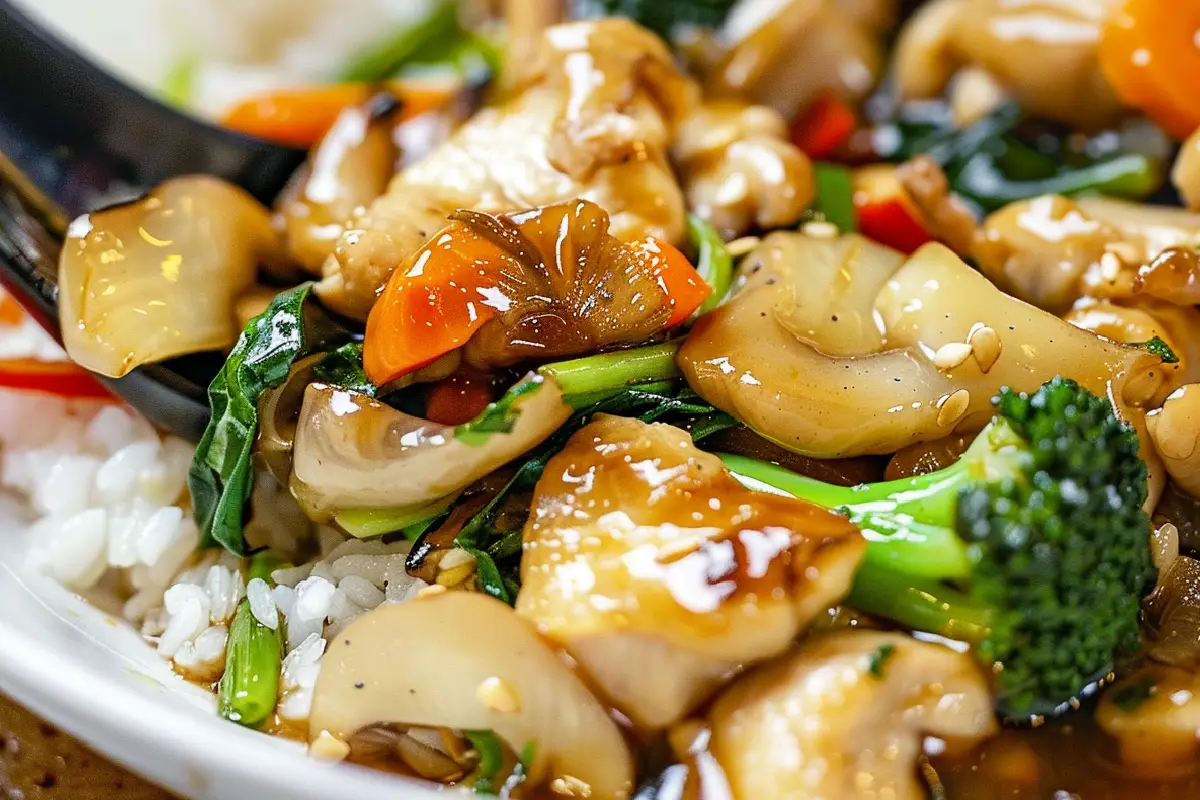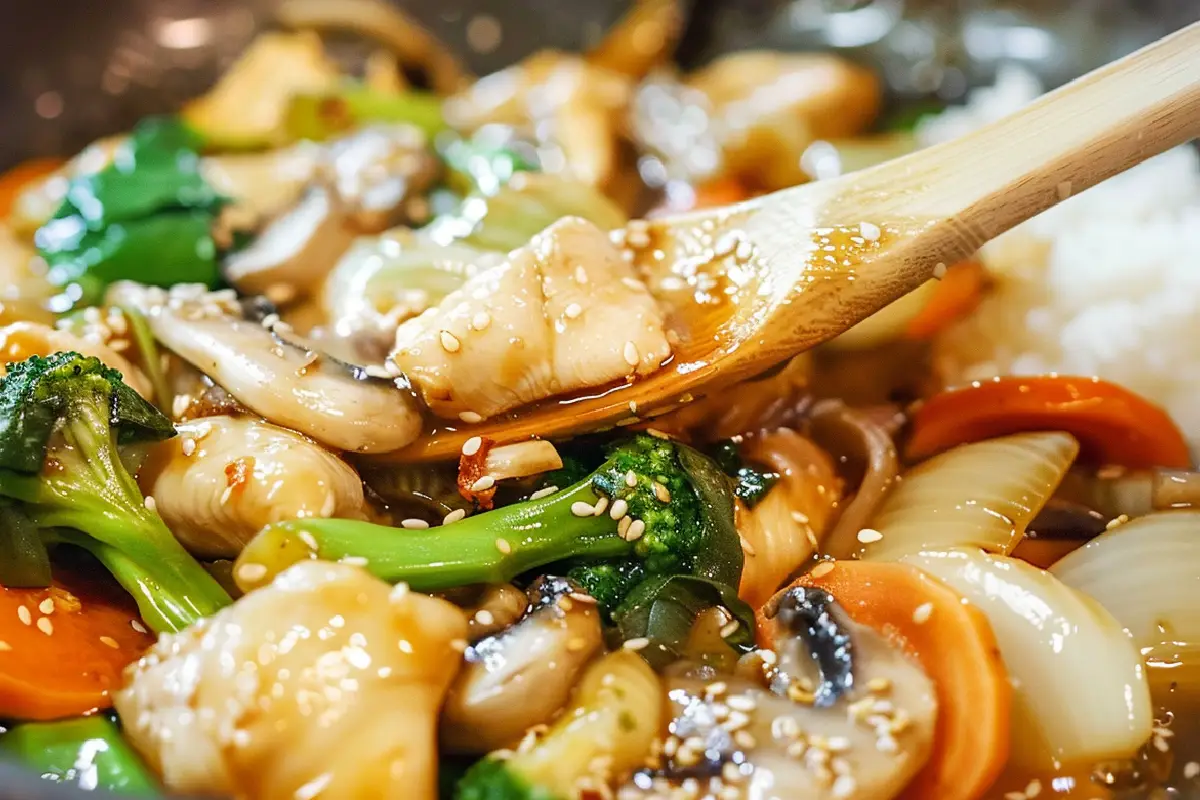Introduction to Moo Goo Gai Pan
Moo Goo Gai Pan is a popular Chinese-American dish known for its tender chicken, crisp vegetables, and light, savory white sauce. The name means “mushrooms and sliced chicken,” highlighting its main ingredients. It originated from Cantonese cuisine and quickly gained popularity in American Chinese restaurants due to its mild flavors, simplicity, and healthy appeal. Unlike other Chinese-American dishes that are often fried or covered in thick sauces, Moo Goo Gai Pan offers a lighter and fresher option that feels satisfying without being heavy.
What is Moo Goo Gai Pan?
Moo Goo Gai Pan is a classic stir-fry that combines thinly sliced chicken with a variety of fresh vegetables. Common choices include mushrooms, snow peas, carrots, bamboo shoots, and water chestnuts. Each vegetable adds its own texture and flavor to the dish. Mushrooms bring an earthy taste, while water chestnuts and bamboo shoots offer a refreshing crunch. Together, they create a colorful, nutrient-rich meal that is as delicious as it is visually appealing.
The true star of Moo Goo Gai Pan is the white sauce, which ties everything together. Unlike the bolder, spicier sauces found in other stir-fries, this white sauce is mild, light, and perfectly balanced. It highlights the natural flavors of the chicken and vegetables without overpowering them, making the dish feel clean and fresh.
This dish stands out from other popular Chinese stir-fries like Kung Pao Chicken or General Tso’s Chicken, which often feature bold, sweet, or spicy sauces. Moo Goo Gai Pan appeals to those who enjoy a gentler flavor profile but still want a dish with depth. The white sauce provides a subtle savory note that enhances the freshness of the other ingredients.
If you plan to make this dish at home, understanding how each ingredient works is important. The balance of the white sauce keeps the dish light, allowing the vegetables and chicken to shine. For more ideas on how sauces can elevate stir-fries, you might enjoy this seafood boil sauce recipe that also uses cornstarch to create a thick, glossy finish.
Overview of the White Sauce

The white sauce in Moo Goo Gai Pan is light and mildly savory, making it different from other Asian sauces like teriyaki or black bean sauce. Instead of being heavy or overly salty, this sauce serves as a gentle backdrop that highlights the fresh ingredients. Its delicate flavors let the vegetables and chicken stand out, making each bite balanced and enjoyable.
Unlike many sauces used in Chinese-American cooking, which are often dark or sweet, the white sauce remains light and helps enhance the dish. This makes Moo Goo Gai Pan a great choice for those who want a flavorful meal that doesn’t feel too rich.
The key ingredients in the sauce include chicken broth, cornstarch, garlic, ginger, soy sauce, and rice wine. Together, these elements create a versatile sauce that you can easily adjust to fit your taste. For more on creating balanced and tasty sauces, you might enjoy exploring this tangy deviled eggs with relish recipe that also balances spices and textures well.
Basic Ingredients of the White Sauce
The white sauce relies on simple ingredients that work together to create its smooth and flavorful profile:
- Chicken Broth: Chicken broth forms the base, providing a savory and rich foundation. Choosing low-sodium broth helps you manage the saltiness while adding depth.
- Cornstarch: Cornstarch acts as the thickener, giving the sauce its smooth, glossy texture. When mixed with water to form a slurry, it blends into the broth without clumping.
- Garlic and Ginger: These aromatics add depth and a bit of spice, boosting the overall flavor of the sauce. Ginger adds a warm, slightly peppery taste, while garlic brings a sharp, pungent note.
- Soy Sauce: A small amount of soy sauce adds saltiness and umami, enhancing the taste without making the sauce too dark.
- Rice Wine: Rice wine, like Shaoxing wine or dry sherry, adds gentle sweetness and complexity. It balances the savory notes and provides a subtle flavor that enhances the dish.
How to Make the White Sauce
Creating the white sauce for Moo Goo Gai Pan is simple and quick. Here’s how you can make it:
- Mix the Base Ingredients: Combine chicken broth, soy sauce, rice wine, garlic, and ginger in a bowl. This forms the base, giving the sauce its savory and aromatic flavors.
- Prepare the Cornstarch Slurry: In another bowl, mix cornstarch with cold water to create a slurry. This step helps the cornstarch dissolve smoothly and thicken the sauce without clumps.
- Add the Slurry to the Broth Mixture: Slowly pour the cornstarch slurry into the broth mixture while stirring. This will thicken the sauce evenly.
- Cook the Sauce: Heat the mixture over medium heat, stirring as it thickens. The sauce will become glossy and slightly thick, coating the back of a spoon when it’s ready.
- Adjust the Seasoning: Taste the sauce and adjust as needed. You can add more soy sauce for saltiness, a splash of rice wine for sweetness, or a dash of pepper for a bit of spice.
Detailed Look at Each Ingredient
Each ingredient plays a key role in the sauce, and knowing them helps you customize it to your liking:
- Chicken Broth: The quality of chicken broth greatly affects the flavor. Using a good broth, whether homemade or store-bought, adds depth and enhances the dish. Low-sodium options help keep the salt level in check.
- Cornstarch: Cornstarch thickens the sauce without changing its flavor. It creates a smooth, glossy finish that clings to the chicken and vegetables, enhancing the dish’s appeal. For another example of how cornstarch works in cooking, check out this easy hot honey recipe, which also highlights its thickening effects.
- Garlic and Ginger: These aromatics are staples in Asian cooking, adding fresh, zesty notes. Garlic gives a bold kick, while ginger adds warmth and slight heat. Both are rich in antioxidants and offer health benefits, making them both tasty and nutritious.
- Soy Sauce: Light soy sauce adds just enough saltiness and umami to lift the sauce’s flavor without overpowering it. It’s best to use it sparingly, as too much can make the sauce too salty.
- Rice Wine: Rice wine adds light sweetness and subtle depth. The alcohol evaporates during cooking, leaving a soft, sweet note that pairs well with the other ingredients. If you don’t have rice wine, dry sherry works as a substitute.
Common Variations of the White Sauce
The white sauce in Moo Goo Gai Pan is flexible, and you can adjust it to suit your dietary needs or taste preferences. Here are some popular variations:
- Low-Sodium Version: To cut down on sodium, use low-sodium chicken broth and less soy sauce. Fresh herbs like parsley or cilantro can boost flavor without adding extra salt.
- Gluten-Free Alternative: Replace soy sauce with tamari or coconut aminos, both of which are gluten-free. Make sure to use gluten-free cornstarch as well.
- Vegan or Vegetarian Option: Swap chicken broth with vegetable broth to make the sauce suitable for vegans or vegetarians. This change maintains the sauce’s light, savory qualities.
- Add Some Spice: If you like heat, try adding crushed red pepper flakes or a little chili oil. This small change will give the sauce a spicy kick while keeping it balanced.
- Boost Flavor with Extras: To deepen the flavor, you can add a splash of oyster sauce or a few drops of sesame oil. These extras will enrich the sauce without making it heavy.
Tips for Enhancing the Sauce Flavor
Proper cooking techniques can significantly improve your sauce. Here are some tips to make sure your sauce tastes its best:
- Sauté Aromatics First: Briefly sauté the garlic and ginger in a bit of oil before adding the liquid ingredients. This step intensifies their flavors and helps them blend well into the sauce.
- Simmer to Blend Flavors: After adding the cornstarch slurry, let the sauce simmer for a few minutes. This allows the ingredients to meld, creating a smoother and more cohesive flavor.
- Add Slurry Slowly: Adding the cornstarch slurry gradually helps control the sauce’s thickness. Stir constantly to avoid making the sauce too thick.
- Avoid Overcooking: Be careful not to cook the sauce too long, as it can lose its shine and become too thick. Remove it from heat once it reaches the right consistency.
Serving Suggestions
Moo Goo Gai Pan pairs well with many sides, making it a versatile dish:
- Steamed Jasmine or Brown Rice: Rice is a classic choice that absorbs the sauce and balances the meal. Jasmine rice offers a slightly sweet aroma, while brown rice adds extra fiber.
- Lo Mein or Rice Noodles: For a heartier meal, serve the dish over lo mein or rice noodles. The noodles soak up the sauce, adding a satisfying, chewy texture.
- Steamed Vegetables: Serve Moo Goo Gai Pan with steamed vegetables like broccoli, bok choy, or snap peas for added color and nutrients. The light sauce complements these greens.
- Lettuce Wraps: For a low-carb option, serve the stir-fry in crisp lettuce cups. This presentation keeps the dish fresh and light, perfect for a quick meal.
- Quinoa or Cauliflower Rice: For a healthier twist, try serving the dish over quinoa or cauliflower rice. These sides add nutrients and keep the meal light.
FAQs
What is the white sauce in Moo Goo Gai Pan made of?
- The white sauce combines chicken broth, cornstarch, garlic, ginger, soy sauce, and rice wine. These ingredients create a light, savory sauce that enhances the dish.
Can you make the white sauce without cornstarch?
- Yes, you can use other thickeners like arrowroot powder or tapioca starch. These alternatives work well and maintain the sauce’s glossy texture.
How do you thicken the white sauce for Moo Goo Gai Pan?
- Use a cornstarch slurry, made by mixing cornstarch with cold water. Stir this mixture into the sauce as it cooks to thicken it evenly.
Is the sauce in Moo Goo Gai Pan healthy?
- The sauce is light and low in fat, especially when using low-sodium and low-fat ingredients. It’s a healthier choice compared to cream-based or heavy soy sauces.
Can the white sauce be made vegan or vegetarian?
- Absolutely. Replace chicken broth with vegetable broth to make it vegan or vegetarian-friendly without losing flavor.
How can I add more flavor to the white sauce?
- Add a splash of oyster sauce, a few drops of sesame oil, or a sprinkle of white pepper to deepen the flavor. These extras enhance the sauce without overwhelming it.
Conclusion

The white sauce in Moo Goo Gai Pan shows how simple ingredients can come together to create a dish that’s both delicious and satisfying. Its light, balanced profile highlights the chicken and vegetables, offering a refreshing alternative to richer Chinese-American dishes. By mastering a few basic techniques and understanding the role of each ingredient, you can easily make this dish at home. Whether you stick to the classic recipe or tweak it to fit your tastes, Moo Goo Gai Pan remains a delightful, wholesome meal that captures the essence of fresh cooking. Next time you crave stir-fry, let the gentle charm of this dish shine in your kitchen.

